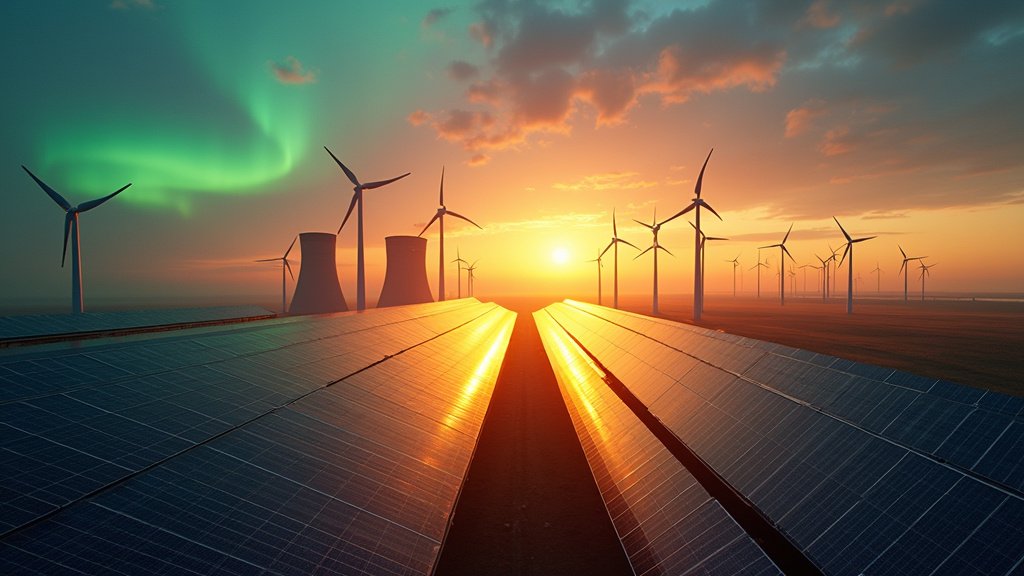For the first time in recorded history, renewable energy sources have generated more electricity globally than coal during the first half of 2025, marking a pivotal moment in the world’s energy transition. This significant shift, detailed in a new report by the clean energy think tank Ember, underscores the rapid ascent of solar and wind power in meeting the planet’s growing electricity demands.
A New Global Power Dynamic — Renewable energy
From January to June 2025, renewable energy sources collectively produced 5,072 terawatt-hours (TWh) of electricity, accounting for 34.3% of the global total. In contrast, coal-fired power plants generated 4,896 TWh, representing 33.1% of the global electricity mix. This marks a significant change from the same period last year, when coal held a larger share. This news is part of a broader trend showing the increasing dominance of clean energy.
Raul Miranda, Ember’s global program director, declared, “The renewables revolution is unstoppable.” He added that renewables are demonstrably meeting the world’s growing electricity demand, powering economic growth, and enhancing energy security. Małgorzata Wiatros-Motyka, Ember’s Senior Electricity Analyst and lead author of the report, stated that “Solar and wind are now growing fast enough to meet the world’s growing appetite for electricity. This marks the beginning of a shift where clean power is keeping pace with demand growth”.
Drivers of the Renewable Surge
The extraordinary growth in renewable energy is primarily attributed to record-breaking expansion in solar power, complemented by steady progress in wind energy. Global electricity demand rose by 2.6% in the first half of 2025, an increase of 369 TWh. Remarkably, solar power alone met 83% of this demand surge, growing by 306 TWh (a 31% increase). Wind energy contributed an additional 97 TWh (a 7.7% increase), ensuring that the combined growth from renewables not only met but exceeded the total rise in global electricity demand.
This surge has led to a slight decline in overall fossil fuel generation, which fell by 0.3% (-27 TWh). Coal generation decreased by 0.6% (-31 TWh), while gas generation saw a 0.2% drop (-6.3 TWh). As a result, global power sector emissions experienced a slight reduction of 0.2%, or 12 MtCO2, in the first half of 2025.
Global Trends and Regional Divergences
Key economies like China and India have been significant drivers of this renewable energy boom, with their clean generation growth outstripping demand and leading to a fall in fossil fuel use and associated emissions. China, in particular, added more solar and wind capacity than the rest of the world combined in the first half of 2025.
However, the global picture is not uniform. In the European Union and the United States, fossil fuel generation saw an increase. This was partly due to adverse weather conditions affecting wind and hydropower output in the EU, and in the US, electricity demand growth outpaced the expansion of its renewable sector. These regional variations highlight the complex dynamics of the ongoing global energy transition.
Implications and Future Outlook
The milestone of renewables surpassing coal signifies a “crucial turning point” in the global energy landscape. Experts suggest this trend is likely to continue, with the “exponential rise” of solar and wind capacity expected to cement the decline of fossil fuel generation. The International Energy Agency (IEA) projects that renewables will become the world’s largest source of electricity by the end of 2025 or by mid-2026 at the latest, and will account for nearly 45% of global electricity generation by 2030.
This transition brings significant environmental benefits, including reductions in greenhouse gas emissions and air pollution, directly contributing to climate change mitigation efforts. Economically, it fosters job creation, spurs technological innovation, and reduces reliance on imported fossil fuels, thereby enhancing energy security. To fully capitalize on the potential of renewables, there is a recognized need for increased investment in clean flexibility solutions, such as advanced grids and energy storage systems.
This unprecedented shift underscores the accelerating momentum of the global energy transition, paving the way for a cleaner, more sustainable, and secure energy future.
Sources: Reuters




